
|
Sale 30
Manuscript and Collectibles Auction
| Lot |
Photo |
Description |
Realized |
Lot 1176 |
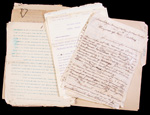 |
Archive of Anna M. (Nugent) Edmonds, 1870s-1910. Archive of original typescripts and manuscripts by Anna M. (Nugent) Edmonds, aproximately 100 pages, c. 1870s-1910, New Orleans, Louisiana. Anna Nugent was reared in an old Louisiana family that settled in St. Landry Parish after 1690. Seven sons served in the Confederate Army and the family fled from advancing Federal troops in 1862. Ironically, in 1875 Miss Nugent married a Yankee entrepreneur, Captain James E. Edmonds of Ohio, who served in the 94th Ohio Volunteers. During Reconstruction he bought "Buck Ridge," a 1,000 acre cotton plantation in the Delta region of Mississippi. Here, with his Southern belle bride, Edmonds proceeded to live like the planters' sons he had recently helped vanquish. Anna Edmonds began writing short stories under the pseudonym Nathaniel Neugent. Her pieces were of that once-popular sentimental genre that relied heavily on Negro dialect for a sense of place and mythologized the finer aspects of life in the Old South. Quite often the tales were based upon her own experiences before, during, and after the Civil War. This archive includes two manuscripts, most likely written while the Edmonds lived in Mississippi. The stories are "Hazards of New Fortunes" and "A Successful Runaway"; the former is penned on thin, tissue-like paper, while the latter is penciled on lined ledger paper. Also included are four typescripts for "The Banshee of the Stoddards," "How Elder Bolivar Elected Himself," "Aunt Sally's Victory," and "Uncle Bill as a Labor Agent"; these stories are written for submission to a publisher, giving word count and return address. There is also a typed excerpt from "Reminiscence 1832 on a Louisiana Plantation"; this centers around the author's grandfather, Judge Seth Lewis, and gives some family history, as well as an examination of local customs. Some of the material is quite fragile.
Estimated Value $1,000 - 1,500.
View details and enlarged photo
| Realized
$690 |
Lot 1177 |
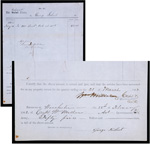 |
(Confederate) Ashby, Turner (1828-1862) Confederate general; killed in action June 6, 1862. Document Signed as Colonel of the 7th Virginia Cavalry (Winchester, March 31, 1862), 1 p. quarto. Ashby approves $55 in payment to George Sibert for 100 bushels of oats. The form is printed "The United States" at top left; "United" was crossed out and "Confederate" written above it. Turner was named commander of Stonewall Jackson's cavalry in October 1861 and commanded a brigade during the Shenandoah Valley cammpaign. He was appointed brigadier general by the War Department May 23, 1862, and on June 2, the district commander gave Turner command of the full cavalry force of the Valley army. Four days later, during a rear-guard action near Harrisonburg, Turner was killed. Fine.
Estimated Value $1,000 - 1,500.
View details and enlarged photo
| Unsold |
Lot 1178 |
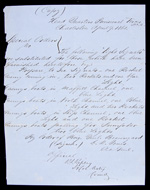 |
(Confederate) Beauregard Prepares Charleston Harbor For Attack - April 9, 1861. Special Orders issued "By Order of Brig. Genl. Beauregard" from Head Quarters Provisional Forces S.C.A., Charleston, April 9, 1861, 1 p. quarto. Written and signed by Assistant Adjutant-General D.R. Jones and marked "Official," this copy was sent to "R.S. Ripley / Lt. Col. Arty Comy." Ripley's headquarters were at Fort Moultrie on Sullivan's Island. Written on pale blue paper; uneven left margin affects part of initial letters on four lines, but does not affect legibility. The orders are:
The following "Light Signals" are substituted for those which have been furnished heretofore viz:
Prepare to see Signals - one Rocket
Enemy coming in, two Rockets and one blue Light
Enemys boats in Maffitt Channel, one blue Light
Enemys boats in North Channel, one Blue Light and two Rockets
Enemys boats, in Ship Channel, one blue Light and one Rocket
Enemys boats pulling for Sumpter two blue Lights.
By Order of Brig. Genl. Beauregard…."
When South Carolina seceded from the Union on December 20, 1860, there were four Federal installations around Charleston Harbor: Fort Moultrie on Sullivan's Island, Castle Pinckney on Shute's Folley, Fort Johnson on James Island, and Fort Sumter, which was at the harbor entrance. Six days after the secession ordinance, Major Robert Anderson, who commanded two companies (85 men) of the First U.S. Artillery, secretly moved his troops from Fort Moultrie, which he considered indefensible, to Fort Sumter. Charlestonians angrily demanded that the U.S. Government evacuate Charleston Harbor, but President James Buchanan refused. In January 1861, an attempted relief expedition was turned back by South Carolina shore batteries, and Fort Sumter gradually became the focal point of tensions between the North and the South. When President Lincoln took office on March 4, 1861, he made it clear that he intended to hold Fort Sumter, and on April 8th, Governor Pickens of South Carolina received notice from President Lincoln that a relief expedition was being sent to resupply Fort Sumter. The Confederate cabinet telegraphed Beauregard on April 10th to fire on Fort Sumter, if needed, to prevent the attempt to relieve the fort.
As part of his preparation, Beauregard issued these orders on April 9th pertaining to light signals. On April 10, 1861, Maj. Gen. Beauregard demanded the surrender of the Union garrison at Fort Sumter. Major Anderson refused and at 4:30 A.M. on April 12, Confederate batteries began a 34-hour bombardment. Major Anderson agreed to a truce about 2 P.M. on the 13th and on April 14, he and his garrison marched out of the fort and boarded a ship to New York. The war had begun.
Beauregard's report on the bombardment and surrender of Fort Sumter, dated April 27, 1861, included praise for Lt. Col. Ripley: "…Of Lieut. Col. R.S. Ripley, First Artillery Battalion, commandant of batteries on Sullivan's Island, I cannot speak too highly, and join with General Dunovant [Brig. Gen. South Carolina Army]…in commending in the highest terms his sagacity, experience, and unflagging zeal…."
Estimated Value $4,000 - 6,000.
View details and enlarged photo
| Realized
$4,140 |
Lot 1179 |
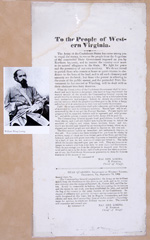 |
Confederate Broadside: "To the People of Western Virginia." Proclamation broadside issued by Confederate Major General William Wing Loring, September 14, 1862, Charleston, Va., 13 x 6½ in. In part: "The Army of the confederate States has come among you to expel the enemy, to rescue the people from the despotism of the counterfeit State Government imposed on you by Northern bayonets, and to restore the country once more to its natural allegiance to the State. We fight for peace and the possession of our own territory…those who persist in adhering to the cause of the public enemy, and the pretended State government he has erected at Wheeling, will be dealt with as their obstinate treachery deserves…." Signed in print by Gen. Loring. Following by an unnumbered General Order from Gen. Loring, congratulating the Army "on the brilliant march from the Southwest to this place in one week and on its successive victories over the enemy at Fayette C.H., Cotton Hill, and Charleston…." A light dampstain in upper left corner touches two words of title, else fine. Rare.
Estimated Value $2,400 - 3,000.
View details and enlarged photo
| Unsold |
Lot 1180 |
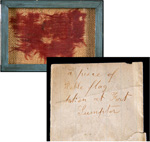 |
Confederate Flag Fragment That Flew Over Fort Sumter. A 5¾ x 3¾ in. piece of frayed red material, accompanied by a folded 4 x 5 in. toned and soiled piece of paper with contemporary handwriting: "a piece of Reble flag taken at Fort Sumpter," housed in a 5 x 7¼ in. period frame. The fragment appears to have powder burns. After withstanding 22 months of siege and bombardment by Union forces, Confederate forces evacuated Fort Sumter on February 17, 1865, leaving the Confederate flag flying, as General Sherman's army advanced from Savannah. When Major General Robert Anderson, who had lowered the U.S. flag on Fort Sumter at the start of the war, raised the U.S. flag four years later, the Confederate flag was cut up as souvenirs by Union officers. This fragment belonged to an Ohio family whose ancestor was at Fort Sumter.
Estimated Value $1,000 - 1,500.
View details and enlarged photo
| Realized
$1,260 |
Lot 1181 |
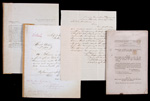 |
(Confederate) Four Documents (1) Imprint of "Ordinances Passed by the [North Carolina] State Convention At Its Adjourned Session," Nov. 1861, 32 pp, 9 x 6 in. Containing 27 resolutions setting the state on a war footing. Bound with string. Dark stains on lower margin of last few pages, some extending into text but still legible; last page torn, with moderate paper loss. (2) Extract of Special Orders No. 164, Richmond, Sept. 27, 186, 1p, quarto. "By Command of the Secy of War." (3) Imprinted General Order No. 17, Richmond, Nov. 7, 1861, 1p, quarto. Providing for Army Regulation changes (4) Request for required paperwork for Callcott Company 's transfer from the 3rd Regt. La. Vols to Lt. Col. Archer's battalion, Smithfield, Nov. 29, 1861, 1 p, quarto. All very good to fine.
Estimated Value $400 - 500.
View details and enlarged photo
| Realized
$240 |
Lot 1182 |
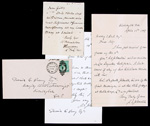 |
Confederate Generals. Wade Hampton (1818-1902): Autogaph Note Signed "W Hampton," n.p., July 16, 1840, 1p, 4½ x3½, with integral leaf addressed to Dr. R.W. Gibbs, Columbia. "Dear Gibbs, Come & take soup with some friends, who meet Fitzsimons & General Montgomery at my house today at 3 oclock.…" Joseph E. Johnston (1807-1891): Two Autograph Letters Signed "J.E. Johnston," Washington D.C., April 15, 1887 and April 14, 1888. The first gives information on the whereabouts of Gen. A.S. Johnston's widow and son; the second regrets that business travel will keep him from visiting the Naugatuck Valley, with transmittal envelop to the Managing Editor of "Transcript" in Birmingham, Connecticut. All fine. (3 items).
Estimated Value $600 - 900.
View details and enlarged photo
| Realized
$719 |
Lot 1183 |
 |
(Confederate) Gist, States Rights (1831-1864) Confederate general; killed at Franklin November 30, 1864. Rare Autograph Letter Signed ("S.R. Gist") as Brigadier General of the 9th Brigade South Carolina Militia, Union Courthouse, March 23, 1860, 1p. octavo. To General J.H. Williams, resigning his military position. Gist writes from headquarters of the 9th Brigade, SCM: "Gen'l Williams / Dear Sir, I here with tender you my resignation as Brig Gen'l of 9th Brig of S.C.M. Being convinced that all prospect of a difficulty has been postponed for years, by the action of Virginia I have concluded to resign my miliitary position. Col W J T Gleem of the 35th Regt is the senior col of the Brigade…." Gist was convinced that there would be no war in the near future because at that time Virginia had shown no inclination to join the other southern states in secession. Without the imminent prospect of war, Gist felt that there was no reason for him to be in the military.
South Carolina seceded on December 20, 1860 and in early 1861, Gist was named Adjutant and Inspector General of the South Carolina state army. He was at Fort Sumter and when Bee was killed at 1st Bull Run, Gist succeeded him in command of his brigade. He returned to S.C. as Adjutant General, was appointed B.G. C.S.A. on March 20, 1862, served on the S.C. coast, then was sent to Vicksburg in May of '63. He commanded Walker's division at Chickamauga and Missionary Ridge, then led his own brigade in the Atlanta campaign. He accompanied Hood on his invasion of Tennessee. During a suicidal charge at Franklin on November 30, 1864, Gist was killed instantly while leading his men on foot after his horse was shot. Out of 26,897 Confederate troops, 6,252 were lost. In addition to General Gist, the Confederates lost Generals Cleburne, J. Adams, Strahl and H.B. Granbury.
Estimated Value $2,000 - 3,000.
View details and enlarged photo
| Realized
$2,070 |
Lot 1184 |
 |
(Confederate) Hardee, William Joseph (1815-1873) CSA general. Letter Signed as Lieutenant General, Head Quarters, Department of South Carolina, Georgia and Florida, Charleston, S.C., January 24, 1865, 1½ pp (1 sheet), quarto. To. Brig. Gen. Saxton, Comdg U.S. Forces, Beaufort, S.C. In part: "I have determined to authorise the sale of cotton within the limits of my department to any agent, or agents, who may be empowered to act under your authority, or that of the Federal fort, at such prices as may be hereafter agreed upon by the contracting parties. Having received a communication from Mr. C.E. Fuller…in which reference to you is made….Mr. Theodore D. Wagner is authorised to effect the sale of cotton in this Department, and I desire him to meet Mr. Fuller…on Saturday, the 28th ins. or earlier if practicable, at some point on the South side of the Saltkehatchie River for the purpose named….W.J. Hardee / Lieut General." Scattered foxing. Lower half of verso has printed information; since paper was in short supply, it was not unusual to reuse it. General Saxton, to whom Hardee wrote, was primarily engaged in the enlistment and organization of Negroes--most of them ex-slaves--into the Federal Army. Hardee's signature is desirable, and in the context of this letter, even more so.
Hardee was one of the finest corps commanders of the Confederacy. In October 1864, he was placed in command of the Department of South Carolina, Georgia, and Florida. Hardee attempted to stop Sherman's March to the Sea, but was powerless before the overwhelming number of Federal troops. On December 17, 1864, Sherman ordered Hardee to surrender, but Hardee successfully evacuated Savannah on December 20th with 15,000 men and went to Charleston. Sherman started north from Savannah on January 15th, and successfully kept the Confederates guessing whether his objective was Charleston or Columbia. This letter, offering to sell cotton, was written during this time. We know that Hardee evacuated Charleston on February 17th to join Johnston's forces in North Carolina, and that Hardee's rear guard, under Wade Hampton, set fire to some 6,000 bales of cotton in the streets of Charleston, contributing to a conflagration that ruined much of the city.
Estimated Value $800 - 1,200.
View details and enlarged photo
| Realized
$1,323 |
Lot 1185 |
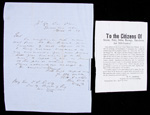 |
(Confederate) Jackson, William H (1835-1903) C.S.A. general. Autograph Letter Signed ("W.H. Jackson") as Brig. Gen. Commanding, Headquarters Cavalry Division, Greensboro, Alabama, April 15, 1865, 1 p quarto. Informing Brig. Gen. P. D. Roddey (miswritten as D.P. Roddy) that he is taking over Roddey's command. In part: "In compliance with orders recd from Lt. Gen. Forrest from Gainsville of date April 13th, I hereby assume command of your command. You will please halt your command, if on the move, & report to me, in person, at this place without delay…." Written during Union General James H. Wilson's raid to Selma (Mar. 22-Apr. 22, 1865), the largest-scale cavalry operation of the entire war. Forrest did not recognize in time that Selma was Wilson's objective, and Jackson's divisions, as well as Chalmers', were prevented from reaching Forrest by Croxton and E.M. McCook. This was Forrest's only failure of the war.
Accompanied by a 6¾ x 5 inch broadside "To the Citizens Of Greene, Perry, Dallas, Marengo, Tuscaloosa, And Bibb Counties," signed in print by Jackson, datedlined Greensboro, Ala., April 15, 1865, informing the inhabitants that he has been authorized by Lieut. Generals Taylor and Forrest to take, by any means necessary, 773 animals needed to mount his command. He orders that all inhabitants give one in five of the total of horses, mares, and mules they possess; anyone who tries to conceal animals will have half of all his animals taken.
Estimated Value $600 - 800.
View details and enlarged photo
| Realized
$2,185 |
Lot 1186 |
 |
(Confederate) Johnson, Bradley T (1829-1903) Confederate general, 1st Maryland. He invaded Pennsylvania with McCausland a year after Gettysburg on Early's orders to slow the arson of Sheridan in the Shenandoah Valley. Autograph Letter Signed, n.p., July 14, n.y. 1p quarto. An interesting letter to his sister, Mrs. H.J. Schley. In part: "Your letter…has caused some changes in our plans which were to go by way of New York Niagara….I sympathize with you deeply…& pray you avoid all kinds of 'instructions' or anything of the sort from all manner of Jesuits man or woman…." Boldly written and signed.
Estimated Value $300 - 400.
View details and enlarged photo
| Unsold |
Lot 1187 |
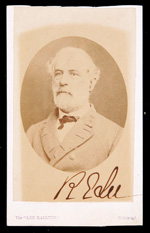 |
(Confederate) Lee, Robert E (1807-1870) Commanding general of Confederate forces. Carte-de-Visite Photograph Signed "R E Lee" at lower right in black ink. The head-and-shoulders portrait of Lee in uniform was taken in 1864 by Richmond photographer J.W. Davies whose imprint is on the verso; the lower front edge of the mount is imprinted "The 'Lee' Gallery' / Richmond." Unevenly trimmed at top edge, not affecting the image. Although the photograph seems not to have existed in a larger original negative, it was a favorite with the General and Mrs. Lee. In this picture, Lee had begun to trim his beard shorter than had been his wont earlier in the war. He had worn a full beard for only three years; the fact that he gradually began to wear it in closer style is a detail that helps to establish the probable sequence of undated photographs. Throughout the rest of his life, his beard will be seen much as it appears in this photo. This image is shown on page 47 of Roy Meredith's The Face of Robert E. Lee, printed in 1947.
Estimated Value $6,000 - 8,000.
View details and enlarged photo
| Realized
$4,600 |
Lot 1188 |
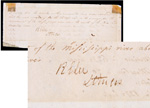 |
(Confederate) Lee, Robert E. Document Signed ("R E Lee / Lt Engrs"), n.p., c. 1837, 1 p., 3 x 8 in. The document says, "I certify that the articles within enumerated have been received and that they were necessary for the buoys used in the surveying of the Mississippi River abouve the mouth of the Ohio and Missouri River." Small adhesion stains in corners and two small tape remnants on verso of top corners. The document is written on the back of another document dated 1837, with moderate show-through. Lee's signature is nice and strong.
Robert E. Lee graduated from West Point in 1829 and was commissioned a second lieutenant in the Army Corps of Engineers. His first important command came in 1837, when, as a first lieutenant of engineers, he supervised the engineering work for St. Louis harbor and the upper Mississippi and Missouri rivers. His work would earn him a promotion to captain.
Estimated Value $3,500 - 4,500.
View details and enlarged photo
| Unsold |
Lot 1189 |
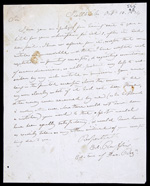 |
(Confederate) Ruffin, Edmond (1794-1865) Ardent states-rights advocate who fired the first short at Fort Sumter; he wrapped himself in the Confederate flag and committed suicide when Robert E. Lee surrendered at Appomattox. Autograph Letter Signed "Ed: Ruffin" as editor of the Farmers' Register, October 10, 1934, 1p, quarto. He apologizes to a subscriber for having sent him a bill after payment had already been received and explains how the mistake occurred. Some spotting and light wrinkling, else very good. Ruffin is known for pulling a lanyard on a 64-pounder Columbiad cannon at 4:30 a.m. on April 12, 1861 and sending the first shell into Fort Sumter, thus beginning the Civil War. Ruffin should also be remembered as an important agricultural pioneer. He dreamed of rebuilding the South, which was impoverished by soil erosion, through agricultural reform.
Estimated Value $300 - 500.
View details and enlarged photo
| Realized
$575 |
Lot 1190 |
 |
(Confederate) Stereoview of Confederate Dead at Gettysburg. Stereocard bearing a double albumen photograph of dead Confederate soldiers awaiting burial near the Rose Farm at Gettysburg, 3 x 6 in. No photographer's imprint on the orange mount.; minor edge wear with small mount loss at upper left, not touching photo; otherwise, very good.
Estimated Value $400 - 500.
View details and enlarged photo
| Unsold |
Lot 1191 |
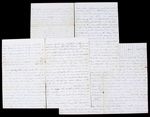 |
(Confederate) (Van Dorn, Earl). Confederate general who was assassinated on May 8, 1863 at Spring Hill, Tennessee, by a man who said Van Dorn had "violated the sanctity of his home"; Van Dorn's friends claimed it was cold-blooded murder, for political reasons. Three months before Van Dorn's assassination, his oldest sister, Octavia (Van Dorn) Sullivane, writes an 18-page letter to their sister Jane, Belvoir (Va), Feb. 5th, 1863, full of news about family, friends, and the war, and defends their brother against the "jealousy" of his enemies: "You need not believe one of the falsehoods that have been circulated against him - he has been abused by the miserable editors because he offended them when he first took command of the Department of Miss…That caused jealousy among Gen. Price's friends who were ready and eager to catch at anything to injure Earl" She describes noteworthy actions of "Earl's," including having Judge Sharkey arrested (he was acquitted) for trying to depreciate Confederate money, and declaring martial law in the Dept., threatening to arrest any editor who published anything relating to troop movements, etc. This caused editors, who "lead the people by the nose at will" to circulate "vile slanders" against him. She notes that "after the disaster at Corinth [he was defeated by Rosecrans] he was terribly abused," and describes the charges brought against him by Gen. Bowen and the Court of Inquiry; he was acquitted, and "The President [Jefferson Davis] said it was the most complete vindication he had ever seen." She describes the cavalry raid against Holly Springs "that saved Mississippi from being overrun by the enemy…Gen. Grant with a large Army was coming down on the Mobile & Ohio R.R. towards Columbus, Miss…when Earl with 5000 Cavalry went up suddenly &…destroyed all of Gen. Grant's stores….Earl has done good service to the South, and it will be acknowledged some day… " She denies rumors that he drinks too much and that his wife is suing him for divorce, and describes his bitterness at being overlooked for promotion. Much more very interesting detail!
Estimated Value $800 - 1,200.
View details and enlarged photo
| Unsold |
Lot 1192 |
 |
Currier & Ives: "The Battle of Gettysburg, Pa. July 3d. 1863". Original hand-tinted print, 9½ x 12¾ in., triple matted and framed to 16 x 19 in. Published by Currier & Ives, 152 Nassau St. New York, c. 1863. A tear at lower edge affects the legend but does not touch the image. Very attractive and ready for display.
Estimated Value $500 - 600.
View details and enlarged photo
| Unsold |
Lot 1193 |
 |
Document For Equipment Lost At Gettysburg. Partly-printed document (Bealeton Station, Va.), Aug. 31, 1863, 2 pp, large folio, concerning the settlement of equipment lost during the battle of Gettysburg by Privates Philip Hartman and White N. Hosler, Co. I, 143rd Regiment of Infantry, Pa. Vols. Listed as lost are items such as knapsacks, a haversack, shirts, blankets, and a canteen. Each man was charged, up to the time of the battle, in excess of $40 each for the equipment, having to pay for some of the lost items. The page was removed from a company ledger; minor damp stains affect some text; overall very good. This document is from a regiment in Abner Doubleday's division that was heavily engaged during the first day's battle.
Estimated Value $400 - 600.
View details and enlarged photo
| Unsold |
Lot 1194 |
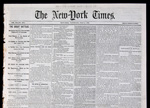 |
Early New-York Times Report of the Battle of Gettysburg. Complete issue of The New-York Times, July 4, 1863, 8pp, 20¼ x 15 in. Reportage (some of it erroneous) of the famous battle that took place July 1-3 fills the entire front page and continues on the back page. Headlines include: "The Great Battles. Full Details of the Battle of Wednesday. No Fighting on Thursday Until Four and a Half, P.M. A Terrible Battle Then Commenced, Lasting Until Dark. The Enemy Repulsed at All Points. The Third Battle Commenced Yesterday Morning at Daylight. The Rebels the Attacking Party. No Impression Made on Our Lines. The Death of Longstreet, and Barksdale of Mississippi Other Prominent Rebel Officers Killed or Wounded. Gen. Sickles' Right Leg Shot Off." Also, page 3 dispatches from Vicksburg dated July 3; it was not yet known that Vicksburg had fallen that day. Binder punctures at left edge, else fine. Handsomely preserved in a custom-made black and burgundy folio, 22 x 16¾ in., with gilt lettering.
Estimated Value $800 - 1,000.
View details and enlarged photo
| Unsold |
Lot 1195 |
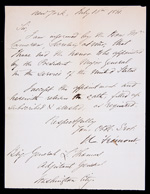 |
Frémont, John C (1813-1890) Union general, explorer and statesman. Autograph Letter Signed ("J.C. Frémont"), New York, July 16, 1861, 1 p octavo. To Brig. Gen. Lorenzo Thomas: "Sir, I am informed by the Hon. Mr. Cameron, Secretary of War, that I have had the honor to be appointed by the President Major General in the service of the United States. I accept the appointment and herewith return the oath, filled up subscribed & attested, as required…." Light toning with a couple of contemporary ink smears, else fine.
Frémont was a controversial character. By 1861, he had already gained prominence as an explorer, saved California for the U.S., been elected governor, court-martialed for defying orders, served in the U.S. Senate from California, and been nominated as the first presidential nominee of the new Republican party (1856). President Lincoln appointed him Maj. Gen. USV on July 3, 1861, in command of the newly-created Western Department. It is this appointment that Fremont writes to accept. Before the end of the year, President Lincoln would dismiss Frémont from his command.
Estimated Value $700 - 900.
View details and enlarged photo
| Realized
$1,860 |
Lot 1196 |
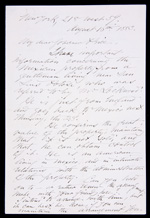 |
Fremont, John C. Autograph Letter Signed ("J.C. Frémont"), New York, August 16, 1883, 2 pp, octavo. To "My dear Governor Price," regarding land in Mexico. In part: "I have important information concerning the Mexican property from a gentleman living near San Luis….He confirms the great value of the property, maintaining that it is not sold, and that he can obtain control of it. He is an American living in Mexico and in intimate relations with the Administrator of the property….I intend to arrange with him, but it can best be done if you can maintain the arrangement you formerly made here.…" Frémont had played a role in wresting territory from Mexico during the Mexican War. Over 35 years later, he was still trying! In his later years, he depended on his wife's (Jessie Benton Frémont) income from writing.
Estimated Value $500 - 600.
View details and enlarged photo
| Realized
$460 |
Lot 1197 |
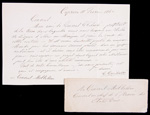 |
Garibaldi, Giuseppe (1807-1882) Italian nationalist leader, patriot and soldier. Autograph Letter Signed ("G. Garibaldi"), Caprera, February 11, 1862, 1 p oblong octavo. Written in French during the American Civil War to General George McClellan, Commander-in-Chief of the Army of the United States, presenting a comrade-in-arms, General Ghilardi, who is on his way to offer his services to Mexico, and who wants to ask McClellan's assistance with an unnamed project. In 1860, Garibaldi had conquered the kingdom of the Two Sicilies and taken Naples. Later in 1862, he would lead a volunteer corps against Rome, which remained outside the new kingdom; he was defeated but given a pardon by the king. With translation, engraving of Garibaldi, and address portion of envelope.
Estimated Value $350 - 450.
View details and enlarged photo
| Realized
$518 |
Lot 1198 |
 |
Gettysburg Letter From A Member of the Excelsior Brigade. Four-page quarto letter written by Eseck G. Wilber, who served as a private in Company K, 120th New York Volunteers, of the famous Excelsior Brigade (III Corps, 2nd Div.), under Daniel Sickles. The Excelsior Brigade had the fifth highest number of killed and wounded in the war. Written in pencil to Wilber's father and mother from "Camp in the Mountains of Maryland July 10th 1863" and filled with details from Gettysburg. In part:
"…I told you that we soon expected a fight and we have had it and a hard one to and now we are after the retreating enemy hot and hevy bound to make them surrender or Butcher the whole of them….we went to Gettersburge Pa….the next day was the 2d of July and this will be a day long to be remembered by the survivers of that terable battle. the fight began in good season in the morning that is Canonadeing: in the afternoon it begun hot and hevy on all sides the thunder of the Artilery and the peals of musketry farely made you deaf. our Brigade chose there Position and lay down behind our stacks watcing for our time to Come….at first it appeared to be going in our favor at this point (our position being near the Centre of the line) but it soon became evident that they were driving us….with one wild yell we advanced on the enemy but they were comeing to strong …at this time they had a cross fire on and and they were poreing in from three different waysk…the musket balls was thicker than any hail I ever saw: My Comrads were falling on evry side of me…Captain Barker fell shot dead instantly the ball went through his head just back of his ears right through his brain. I saw him fall he never groaned at all. he had his swoard raised over his head giving us orders….they drove us about half a mile when our battery took a new position and we were reinforced by one brigade and with one wild yell we rallied to our collors and drove them back…we drove them all prisoners except a very few. in our Company we lost 5 men killed 16 wounded and 2 missing. we went into the fight with 40 men and the next day…we could not muster but 9: the regment went in with 346 muskets and came out with 110…the next day the fight raged all day with fury…we have got General Lee in a tight place…we have took about 16,000 Prisoners…we have lost at least 20,000 and I think more….the army that 2 months ago was almost demorilised has won a victory that will long be remembered. General Lee flushed with the hope of a successful result has tried himself the seckond time in Pensilvania and Mariland but he has found a man that is redy to meet him on evry corner and he has got badly whiped….we thought we had hard fighting to Chanselorville but it was not a flee bite to this one…. Much more excellent content, including a description of three musket balls that grazed him on various parts of his body. After surviving Gettysburg, Wilber was captured on October 10, 1863, during the Bristoe Campaign. He was sent to Andersonville, where he died the following September. Copies of Wilbur's war records are included.
Estimated Value $2,500 - 3,500.
View details and enlarged photo
| Realized
$4,140 |
Lot 1199 |
 |
Halleck, H.W. & Morell, George W. Union generals. Document Signed ("Geo. W. Morell / Brig. Genl") approving an unengrossed requisition form for forage for private horses in the U.S. Army, n.p., n.d., 1p. quarto. On the verso of the form is an order from the War Department, Washington, Dec. 16, 1862, Signed ("H W Halleck / Genl in Chief"). Marked "Copy" and directed to Maj. Gen. Geo. W. Morell, it says, "The Secretary of War directs that Maj. Genl Morell turn over his Command to Brig Genl Kelly and report in person to the Adjutant General of the Army in Washington." Light toning, one partial fold split and one edge tear, not affecting either signature.
Estimated Value $500 - 750.
View details and enlarged photo
| Realized
$312 |
Lot 1200 |
 |
History of the War for the Union: Civil Military & Naval. By E.A. Duyckinck, 32 pp uncut, with illustrations by Alonzo Chappel. Published by Johnson, Fry & Company, New York, c. 1862. A "Companion to the Battles of the United States," the price was 25¢. Wear to edges. Nice plate of Gen. McClellan and inside title page engraving of the flag at Fort Sumter being consecrated. With The History of the United States, by J.A. Spencer, New York: Martin, Johnson, and Co., c.1856, 24 pp. Covering 1492-1609; tattered covers but with nice steel engravings of Washington and Patrick Henry.
Estimated Value $50 - 100.
View details and enlarged photo
| Realized
$36 |
Lot 1201 |
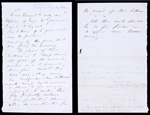 |
McClellan, George (1826-1885) Union general; presidential candidate in 1864. Autograph Battle Orders unsigned as commander of the Army of the Potomac, n.p. (April 16, 1862), 1 1/3 pp (one sheet). Important orders issued to start the siege of Yorktown, a major event during the Peninsula campaign, given to Henry L. Abbott, 1st Lt. Topographical Engineers. McClellan writes: "Direct Barnard to order an officer of Eng. to Gorman's brigade to lay out two batteries of 6 guns each near the positions occupied by the guns that were firing this morning. The object of these batteries is to keep down the fire of the enemies works and to prevent him from constructing new ones. they may be half sunken batteries with rough embrasures & should also be constructed for the guard of othe batteries. All these works should be so far finished as to afford cover tomorrow morning." Abbott writes in pencil below the orders, "This is a manuscript order of Gen. McClellan. I was ordered to do the work April 16, 1862…." He added another note, probably later, "They proved to be batteries 7 and 8 - of which 7 was the first of our works of the siege." Abbott, who was later promoted to Bvt. Maj. Gen., was in charge of siege artillery for Grant during the siege of Pittsburg. War-date battle orders of McClellan are very scarce. These are boldly written and in fine condition.
Estimated Value $800 - 1,000.
View details and enlarged photo
| Unsold |
Lot 1202 |
|
McClellan, George B ((1826-1885) Union general; Democratic presidential nominee in 1864. Autograph Letter Signed, New York, Nov. 19, 1883, 1½ pp, octavo. To Col. H.L. Albert in regard to arrangements for meeting at an exhibition of the Sims Topedo. This cigar-shaped device traveled at the surface of the water, propelled by an electric motor developed by Thomas Edison, and was controlled by an operator on shore. Two pinholes and light red pencil mark at top right, else fine.
Estimated Value $300 - 400.
View details
| Realized
$192 |
Lot 1203 |
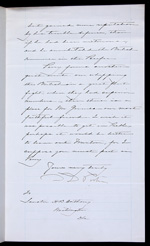 |
Porter, David Dixon (1813-1891) Union Admiral. Letter Signed "D.D. Porter" as Admiral of the Navy, Washington, D.C., Feb. 26, 1874, 2pp (joined), folio. To Senator H.B. Anthony, discussing which Naval officers should be placed in the panels of the Navel Committee Room. In part: "Confine the list to those of the Revolution and 1812, and let those of the present Era take their chances hereafter. First comes Paul Jones who represents the Revolution….Then Truxton, who in the Quasi War with France, captured two frigates with a smaller ship the Constellation. Then comes the Era of 1812--Commodore Porter was a second Paul Jones…he annihilated the British commerce in the Pacific. Perry forms another grreat event, our whipping the British in a great fleet fight.…" More excellent content. Grayish toning to upper 1½ in. of first page, else fine.
Estimated Value $300 - 500.
View details and enlarged photo
| Realized
$444 |
Lot 1204 |
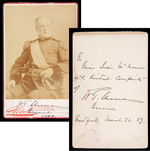 |
Sherman, William T (1820-1891) Union general; famous for his "March to the Sea." Cabinet Photograph Signed "W.T. Sherman General 1899" on the mount, over the photographer's stamp: "Gen. Sherman. Copyright 1888 by Napoleon Sarony…." The sepia-toned photo shows a three-quarter, seated portrait of Sherman in full uniform, his left hand on the hilt of his sword. On the verso, Sherman Inscribes and Signs: "To Miss Jessie McNamer with kindest compliments of W.T. Sherman General, New York March 26, 89." Edge wear to mount. One faint crease left of top center runs just in front of Sherman's right ear, but is visible only above his head from a distance. Very desirable.
Estimated Value $1,600 - 1,800.
View details and enlarged photo
| Unsold |
Lot 1205 |
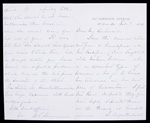 |
Sherman, William T. Autograph Letter Signed ("W.T. Sherman") on the day before he retired from the Army, St. Louis, Missouri, Feb. 7, 1884, 4 pp., octavo. To Mary Audenried, widow of Sherman's aide, Col. Joseph C. Audenried, whom Sherman had taken under his wing after her husband's death and, some think, to his bed. Mary had a wayward daughter, Florence, who led her on a merry chase. Sherman congratulates Mary for putting Florence in the convent at Manhattanville. In part, "…At that convent they will make her conform to their rules and will stop her correspondence with the boys….If Florence has been corresponding with some boy under cover to Miss Daisy Ricketts, I advise you to call on Mrs. Ricketts…and say to her that you expect her…to assist you in stoppping this clandestine channel of communication….It is infinitely better that she should be at Manhattanville than Washington where she would worry your life out of you. It was too bad she should have spoilt your visit to Saint Louis….With love & affection…."
President Rutherford B. Hayes wrote to Sherman in June 1880, asking him to pay a visit to Mrs. Audenried and give the President's condolences on the death of her husband. According to Michael Fellman's book, Citizen Sherman: A Life of William Tecumsey Sherman, the general and the widow became lovers within six months.
Estimated Value $700 - 1,000.
View details and enlarged photo
| Unsold |
Lot 1206 |
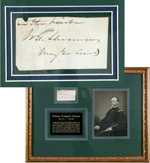 |
Sherman, William T. War-date Signature and rank cut from a letter, "W.T. Sherman / Maj. Gen. Comd." Three other words in Sherman's hand precede his name. Only war-date signatures of Sherman are signed as major general commanding. Matted with a 7¼ x 5¼ in. seated engraving of Sherman holding his sword, along with a biographical plaque, and framed to an overall size of 14¾ x 19 in. The Christy green matting, navy liners and gilt frame make this an elegant display item.
Estimated Value $500 - 600.
View details and enlarged photo
| Unsold |
Lot 1207 |
 |
Stereoview of Gettysburg Battlefield. Stereoview card, 3 x 6 in. bearing a double photograph on a peach mount. Published by Tipton & Myers, Gettysburg, Pa., Stereoscopic View No. 576, showing the "Northern portion of Gettysburg, from a position West of the town, near the Theological Seminary." Light wear to edges, else very good.
Estimated Value $400 - 500.
View details and enlarged photo
| Unsold |
Lot 1208 |
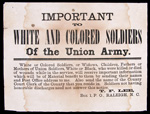 |
Union Occupation Broadside, Raleigh, North Carolina. An extraordinary, previously unknown, Reconstruction broadside signed in print by E.F. Lee, an agent of the U.S. Government, c. 1865, 9½ x 12½ in. The broadside appeals to "White or Corored Soldiers, or Widows, Children, Fathers or Mothers of Union soldiers, White or Black, who were killed or died of wounds while in the service…." They will receive "important information which will be of Material benefit to them" if they send their names and addresses and the name of their County Court Clerk. "Soldiers not having honorable discharges need not answer this notice." Confederate veterans are conspicuously left out of this offer. A large dampstain over much of the broadside does not affect legibility.
Estimated Value $2,400 - 3,000.
View details and enlarged photo
| Realized
$1,208 |
Lot 1209 |
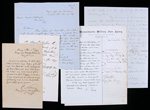 |
Union Officers. Carl Schurz: Letter Signed "C. Schurz" as Maj. Gen. Commanding 3rd Div., 11th Corps, Camp near Burks Station, VA., May 30, 1863. To an unknown recipient, stating that Cap. Wilers of the 119th Regt. NY Vols conducted himself gallantly on the battlefield of Chancellorsville. The New York press had accused the "German" regiments of cowardice. Franz Sigel: Autograph Letter Signed "F. Sigel," New York, July 17, 1872, 2pp (joined) octavo. To Mr. Dawson, who was preparing "war-papers," mentioning numerous officers and what he knew of what happened to them. William S. Rosecrans: Letter Signed "W.S. Rosecrans" as Lieut. Corps of Engineers, Engineering office for Fort Adams, Newport, R.I., Jan. 24, 1849, 1p, 8 x 8 in. with integral address leaf. To Messrs. Cornett & Nightingale, ordering wrought iron pipe. David Dixon Porter: Letter Signed as Admiral of the Navy, Washington, D.C., May 16, 1887, 2pp, octavo (1 sheet), giving information on the location of the late Admiral Farragut's house and of "Mrs. Admiral Fairfax, the daughter of Admiral A.H. Foote…." Benjamin F. Butler: Document Signed "Benj F. Butler" as Brig. Gen Comg. on Massachusetts Military State Agency, Washington, D.C., March 22, 1867, certifying to the commissioning of Ben Perley Poore as Major in the 8th Regt. of Mass. Vol. Militia and to his mustering out and honorable discharge. Daniel E. Sickels: Letter Signed "D.E. Sickels," New York, 1842, 2pp (1 sheet) quarto, as lawyer for a Revolutionary War widow seeking a pension. All fine. (6 items).
Estimated Value $600 - 800.
View details and enlarged photo
| Realized
$456 |
|
|